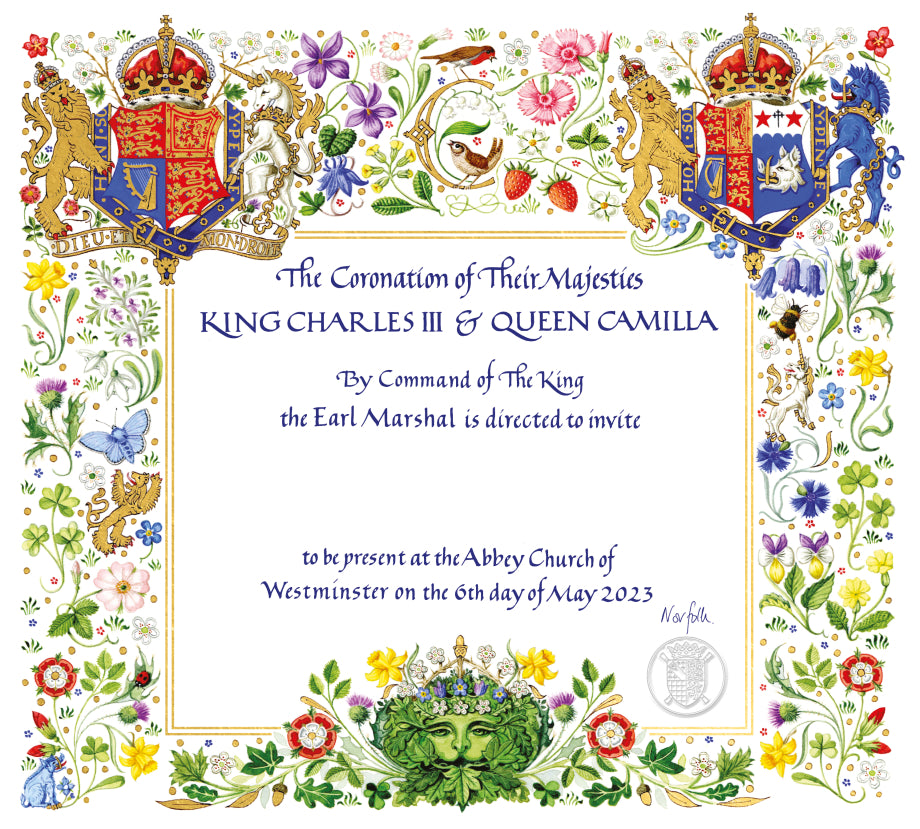
An Interview Andrew Jamieson, the designer of King Charles III's Coronation Invitation
The invitation for the Coronation has been designed by Andrew Jamieson, a heraldic artist and manuscript illuminator. He is a Brother of the Art Workers’ Guild, of which The King is an Honorary Member.
Recently, I contacted Andrew Jamieson, and he happily answered questions giving insight into his creative process and how he designed and created the exquisite "Invitation to the Coronation”.

Invitation to the Coronation
The original artwork for the invitation was hand-painted in watercolour and gouache, and the design will be reproduced and printed on recycled card, with gold foil detailing.
Central to the design is the motif of the Green Man, an ancient figure from British folklore, symbolic of spring and rebirth, to celebrate the new reign. The shape of the Green Man, crowned in natural foliage, is formed of leaves of oak, ivy and hawthorn, and the emblematic flowers of the United Kingdom.
The Interview
Thank you very much, Andrew Jamieson, for taking the time to answer these questions and for sharing your valuable insights into your creative process.
Were you invited to design the ‘Invitation to the Coronation’, or was there a selection process?
His Majesty is an Hon. Brother of the Artworkers Guild, and several artists were invited to submit designs for the invitation. Mine was chosen and I was then asked if I would like to work on the project.
Exactly how was the design for Invitation developed? Was there a detailed design brief?
No design brief – the design was all mine. Inspired by wildflower meadows, the royal flowers and the Green Man, the coats of arms of Their Majesties and His Majesties work in creating beautiful peaceful environments.
Were you asked to include any specific symbolism in the design?
No – The whole concept of the piece was my idea completely, as I said I had free rein. The rough was submitted and chosen. The Green man is a symbol of new beginnings and Spring.

Please outline the different stages in creating The Invitation for the Coronation, from the initial design to the finished piece.
I submitted a rough and once the design was chosen I set to drawing it out carefully on Fabriano paper and then it was a case of painting it. I tend not to over think designs and sometimes change things as I am working, it is a very fluid and organic process. I kept mostly to the rough but changed a few floral elements to make them flow better.
Once you knew the elements and symbolism to include, how did you go about incorporating all these components into the border design?
I knew the elements and the symbolism I wanted to include from day one when I designed it – It was a case of painting the flowers in a simple style and try to get a sense of rhythm in the borders and bring it all together in a balanced harmonious design.

How did you go about choosing the style of calligraphy, letter weight and text layout?
I thought an italic of sorts and names in a Roman style – instinct I suppose, it just made sense to me to reflect the natural rhythm of the flowers and give it that ‘hand written’ organic feel.
Will you be handwriting the recipients’ names on the invitations?
No, that pressure will be on others!
Can you tell us about the tools and materials you used.
I used Windsor and Newton watercolours and gouache and used 00000, 0000, and a 000 sable brushes.
What were the considerations when selecting the materials for the invitation, for example the paper, choice of watercolour and gouache paint?
Watercolour seemed the ideal choice as I wanted to give a lighter feel to the natural elements to juxtapose with the heraldry which was painted in gouache. I chose Fabriano paper because after vellum it is my favourite surface especially the HP surface.
What tools did you use?
2H, 3H, HB pencils, Round Hand steel nibs sizes 3 and 4.
Do you have favourite dip pens and ‘go-to’ stock of materials? Or is this different for every project you work on?
It changes depending on the project but mostly William Mitchell nibs, and swan quills for calligraphy. Mostly gouache paint but combine it with watercolours and acrylics sometimes. 23.5c shell gold powder mixed into paint to a recipe I have refined over my 40-year career. Calf skin vellum, Daler watercolour board and Fabriano paper.

Did you only work in natural daylight or do you use artificial light?
I work in daylight for as long as possible before switching my lamp on. It varies again depending on the project.

How long does it take to produce such a detailed piece of work?
Coats of arms can take anything from a week to a month. An illuminated manuscript page about 4 weeks.
I recently had to design and complete 20 handwritten, hand illuminated vellum certificates for a University in the USA and had two months to complete the commission – very, very long hours on that one, but delivered on time happy to say. Average workday is 8-9 hours. I also work to a disciplined routine. I take the odd Friday and Saturday off to develop my own projects. Currently designing a Holy Grail tapestry.
Can you tell us about any challenges or difficulties you’ve encountered while working on an illuminated manuscript, and how you overcame them?
Not really, my training at Reigate from 1980 to 1983 under Anthony Wood was very thorough. The course he ran was intensive and hard work and when it ceased to be in 1987 it was an end of an era. He took no prisoners and would make you start over even after a weeks’ worth of work if he thought it wasn’t right. I imagine it was the same working as an apprentice for a Master in the Middle Ages. We learnt just about every aspect of calligraphy, tools, materials, working with vellum, design, heraldic design and life drawing, essential if you want to paint heraldry! What I didn’t learn there, I was fortunate to learn from working with Donald Jackson in the mid 1990’s to 2002. Lots of interesting creative processes and different ways of doing things like vellum preparation, gilding and calligraphy.
Finally, what advice would you give to someone who is interested in learning calligraphy and creating illuminated manuscripts?
Find a good tutor like Josie Brown or Timothy Noad. They trained at Reigate under Anthony Wood and they are immensely talented and I think they run classes.
Be dedicated, disciplined and observant and persist!
Andrew Jamieson

Website: www.andrewstewartjamieson.co.uk
Instagram: artyjamie1746
